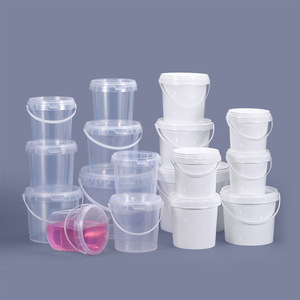
All categories
Featured selections
Trade Assurance
Buyer Central
Help Center
Get the app
Become a supplier

(6026 products available)




















































1-liter plastic containers are commonly made from several types of plastics, each with unique properties and advantages. Here are some of the common types of plastics used for 1-liter containers:
The design of the plastic container includes structural and aesthetic elements to improve functionality and presentation.
Shape and structure
The container has a cylindrical shape with straight sides. This shape makes it easy to stack and store. The bottom is generally flat and sturdy, supporting the container when filled. Some designs include grips or recessed areas to make holding and pouring easier.
Neck and opening
The neck of the container is wide, accommodating filling and emptying. Screw-on caps, snap-on lids, and pouches are types of openings. They are designed to be airtight and tamper-evident to protect the contents and ensure safety.
Materials used
1-liter plastic containers are mainly made of PETE and HDPE plastics. PETE is clear, strong, and shatter-resistant, making it suitable for beverages and non-hazardous liquids. HDPE is opaque and more flexible; it can withstand more impact and is ideal for detergents and chemicals.
Labeling and branding
The design space is for branding and product information. It can stick labels or directly print them using techniques like screen printing. The text should be readable and convey important information like the contents, instructions, and manufacturer details.
Aesthetic considerations
Clear or translucent containers show the contents, helping consumers identify the product. The containers can be tinted or colored to reflect the brand or protect the contents from light. The design can have rounded or sharp edges, and the color can vary to align with the brand image.
These elements of the container design improve the user experience and help the container serve its purpose better. They also contribute to safety, durability, and attractiveness.
Food and Beverages
1-liter plastic food containers are used to store food and drinks. Plastic bottles for drinks, soups, and sauces are manufactured and distributed by companies. Consumers buy these items, and the containers can be recycled or reused.
Household Products
Many household products like detergents, shampoos, and cleaners come in 1-liter plastic containers. These containers provide easy usage and help keep the products safe until use.
Healthcare Industry
1-liter plastic bottles and containers are used in hospitals and clinics to store medicines, IV solutions, and other medical supplies. The containers are usually transparent to allow for easy viewing of the contents and are sealed to ensure sterility.
Laboratory Use
In laboratories, 1-liter plastic containers are used to store chemicals, reagents, and samples. Lab-grade containers are designed to resist various chemicals and prevent contamination.
Industrial Use
Many industries use 1-liter plastic containers to store lubricants, oils, and other fluids. These containers are durable and can handle the contents they carry.
Agricultural Use
Plastic bottles and containers are used to hold pesticides, herbicides, and fertilizers. The containers are designed to withstand various environmental conditions on the farm.
Wholesale buyers of 1-liter plastic containers need to know the details of the product before making a purchase. Here are some factors to consider when choosing a 1-liter plastic container:
Material suitability
Choose the right plastic material based on the type of content that will be stored in the container. For instance, HDPE containers are ideal for chemicals, while PP containers work well with food products.
Container design and shape
Select a design that meets the branding and functional requirements. Consider factors such as ease of filling, pouring, and sealing, as well as the ability to stack or store the containers.
Sustainability considerations
Look for plastic containers that can be reused or made with recyclable materials. Choose containers with a reduced carbon footprint or those that utilize bioplastics. Sustainability is an increasing demand in the market.
Regulatory compliance
Ensure that the plastic containers meet all relevant industry standards and regulations set by the FDA or other health and safety organizations. This compliance is crucial for protecting consumers and avoiding legal issues.
Performance and quality
Choose plastic containers that can withstand the rigors of transportation and storage. Opt for containers that are impact-resistant, durable, and have a long shelf life. The quality of the containers also affects the product inside.
Q1: Are one-liter plastic containers recyclable?
A1: Yes, most one-liter plastic containers can be recycled. But it's essential to check local recycling guidelines to ensure they accept the specific type of plastic.
Q2: Can one-liter plastic containers be used for food storage?
A2: Many one-liter plastic containers are food-grade and safe for food storage. Always check the container's labeling to ensure it meets food safety standards.
Q3: What types of lids do one-liter plastic containers come with?
A3: One-liter plastic containers come with various lid types, including screw tops, snap-on lids, and pump dispensers, offering different sealing methods and accessibility options.
Q4: Are one-liter plastic containers BPA-free?
A4: Bisphenol A (BPA) is a chemical used in some plastics that can seep into food and beverages and potentially pose health risks. Many plastic container manufacturers have moved to produce BPA-free containers. As with food safety, it's essential to check the labeling or manufacturer's specifications to ensure the container is BPA-free.
Q5: What is the shelf life of products stored in one-liter plastic containers?
A5: The shelf life of products in one-liter plastic containers varies depending on the item. For example, sealed and stored correctly, non-perishable foods can last months or years, while detergents and cleaning supplies remain effective for several months. Always check the product label for specific storage and expiration information.